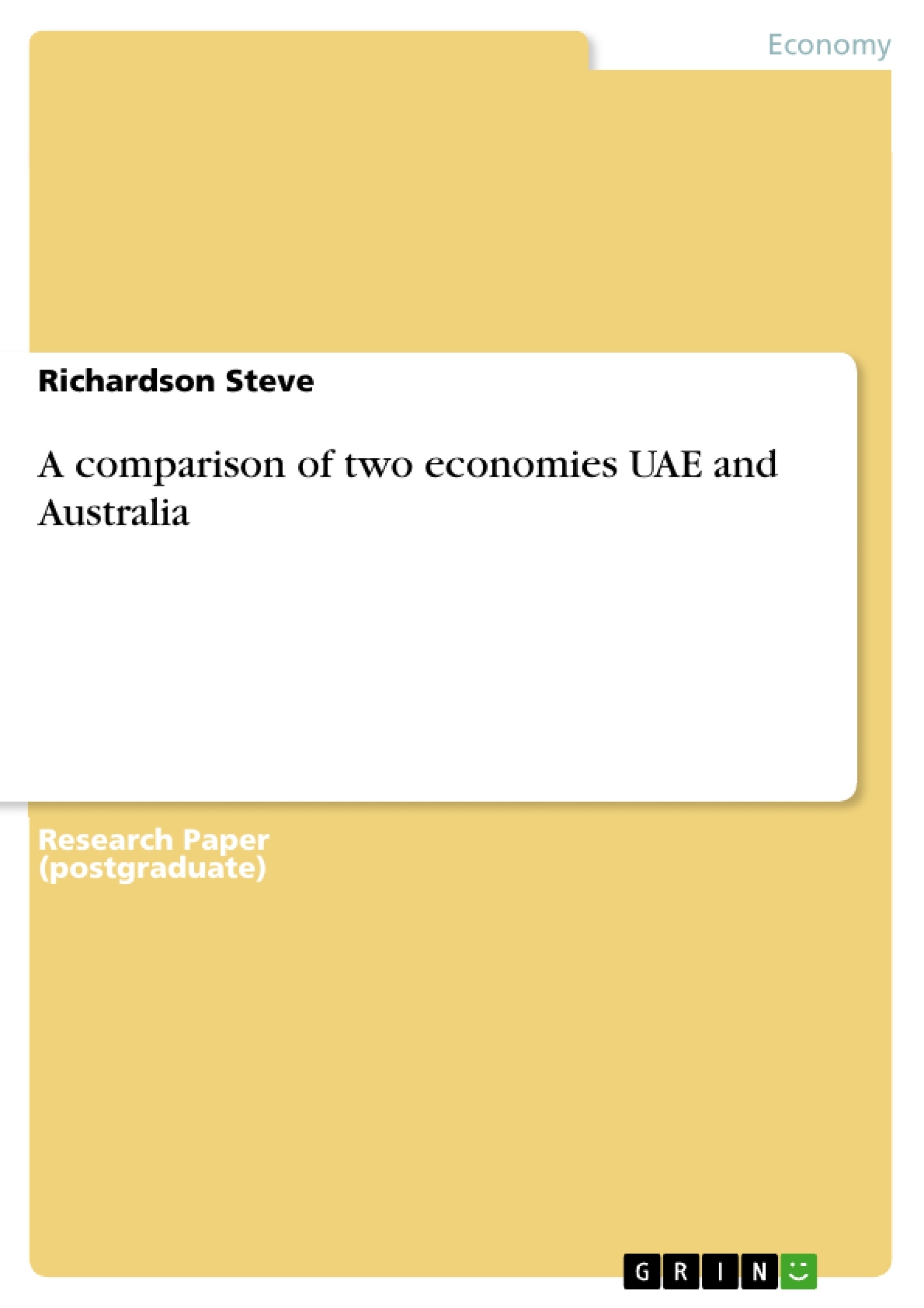In this paper, we describe as well as compare the economies of two countries (United Arab Emirates (UAE) and Australia).We do this by effectively researching the economic characteristics of two national economies, and then selecting a limited number of critical variables which can best be used in describing their similarities and differences. We also research the critical background on the two national economies so as to explain their current economic situation while also suggesting their likely future economic states. The paper begins by presenting a general introduction to the two economies. This is the followed by a detailed and in-depth macroeconomic analysis of Australia’s and UAE’s economies.The specific variables to be compared are GDP and its components final consumption expenditure, General Government final consumption expenditure and gross capital formation,CPI and Inflation, unemployment, Interest Rates, Exchange Rates, Government Spending & Taxes as well as Money Supply. The analysis is specially illustrated and explained by means graph data spanning ten years. A discussion then follows followed by a conclusion on the better economy among the two.
Introduction
A comparison and description of the Australian and UAE economies is important to investors and multinationals who are interested at the country-level suitability analysis. This is because of the advantages of investing in vibrant economy and the risks associated with investing in a shaky economy. In this paper, we present a detailed comparison and description of the Australian and UAE economies with a view of coming up with the most appropriate investment destination.
The Australian Economy
Australia has a GDP of about US$1.57 trillion (CIA,2012).The Australia economy is valued at more than $6.4 Trillion and is the thirteenth largest national economy by virtue of nominal GDP. It is the 17th largest economy when measured by the level of PPP adjusted GDP.It comprises close to 1.7 percent of the global economy. The economy is dominated by the service sector (makes 68 percent of its GDP).The mining sector represents close to 10 percent of its GDP while the mining related economy sector makes 9 percent of the economy (Collebatch,2009).
Inhaltsverzeichnis (Table of Contents)
- Executive Summary
- Introduction
- The Australian Economy
- The UAE economy
- Macroeconomic analysis of the Economies
- Australia
- GDP
- Household final consumption expenditure
- General Government final consumption expenditure
- CPI & Inflation
- Unemployment
- Interest rates
- Exchange Rates
- Government Spending & Taxes
- Money Supply
- United Arab Emirates
- GDP
- Household final consumption expenditure
- General Government final consumption expenditure
- CPI (Consumer Price Index)
- Inflation
- Unemployment
- Interest Rates
- Exchange Rates
- Government Spending & Taxes
- Money Supply
- Conclusion
- References
Zielsetzung und Themenschwerpunkte (Objectives and Key Themes)
This paper examines and compares the economies of the United Arab Emirates (UAE) and Australia, aiming to provide insights into their respective economic characteristics, strengths, and weaknesses. The study utilizes a selection of key macroeconomic variables to illuminate the similarities and differences between these two national economies. Through an in-depth analysis of historical data, the paper aims to shed light on the current economic situations of both countries and to suggest possible future economic trends.- Comparative analysis of key macroeconomic indicators
- Exploration of the economic strengths and weaknesses of both economies
- Assessment of the current economic state and potential future trends
- Identification of potential investment opportunities and challenges
- Evaluation of the relative economic performance of UAE and Australia
Zusammenfassung der Kapitel (Chapter Summaries)
- Executive Summary: This section provides a brief overview of the paper's objectives, methodology, and key findings.
- Introduction: The introduction sets the stage for the paper by explaining the importance of comparing the UAE and Australian economies, especially for investors and multinational companies. It highlights the potential benefits and risks associated with investing in different economies and emphasizes the paper's goal of identifying the most suitable investment destination.
- The Australian Economy: This chapter focuses on the Australian economy, presenting its size and key sectors, including the dominance of the service sector and the significant role of mining. The chapter also highlights Australia's economic freedom and its open-market policies, which contribute to its dynamism.
- The UAE Economy: This chapter provides an overview of the UAE economy, focusing on its size and key sectors. While the specific details are omitted to avoid revealing major insights, the chapter highlights the importance of this economy and its potential.
- Macroeconomic analysis of the Economies: Australia: This chapter delves into the macroeconomic analysis of the Australian economy, examining key variables such as GDP, its components, CPI, inflation, unemployment, interest rates, exchange rates, government spending, taxes, and money supply. The analysis is supported by graphical data spanning ten years, allowing for a deeper understanding of trends and patterns.
- Macroeconomic analysis of the Economies: United Arab Emirates: This chapter mirrors the previous chapter, providing a similar in-depth macroeconomic analysis of the UAE economy using the same key variables and graphical data.
Schlüsselwörter (Keywords)
The primary focus of this research lies in a comparative analysis of the UAE and Australian economies, examining their macroeconomic characteristics, strengths, and weaknesses. The study utilizes key macroeconomic indicators, including GDP, inflation, unemployment, interest rates, and exchange rates, to provide a comprehensive understanding of the current economic state and potential future trends in both countries. The paper aims to shed light on the relative economic performance of these two economies, identifying potential investment opportunities and challenges for businesses and investors.- Quote paper
- Dr Richardson Steve (Author), 2012, A comparison of two economies UAE and Australia, Munich, GRIN Verlag, https://www.grin.com/document/214306



